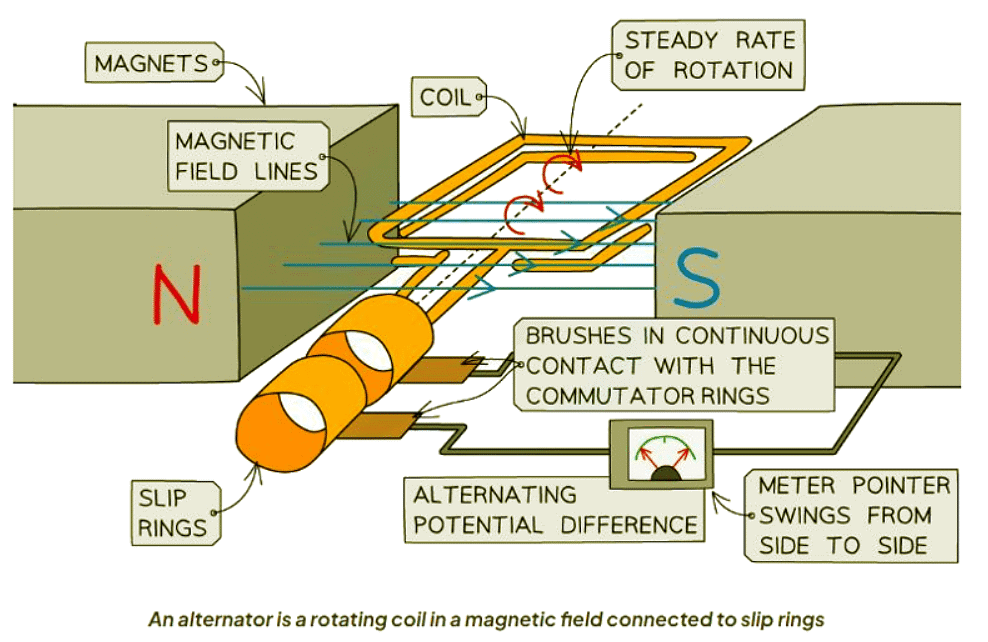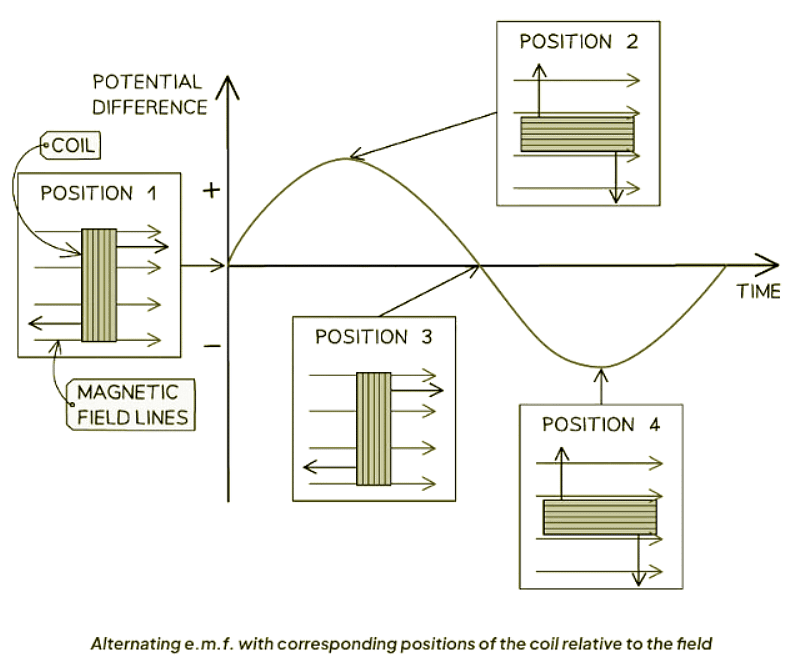Class 10 Exam > Class 10 Notes > Physics for GCSE/IGCSE > The AC Generator
The AC Generator | Physics for GCSE/IGCSE - Class 10 PDF Download
Simple A.C Generators
- The generator effect can be utilized to produce alternating current (AC) in an alternator.
- A basic alternator is a specific type of generator that transforms mechanical energy into electrical energy in the form of alternating current.

- When a rectangular coil rotates within a uniform magnetic field, it causes the pointer of the meter to initially deflect in one direction, then in the opposite direction, and then back again.
- This phenomenon occurs due to the coil cutting through magnetic field lines, inducing an EMF and consequently a current in the circuit.
- The pointer deflects in both directions because the current within the circuit undergoes repeated changes in direction as the coil spins.
- The reason behind this directional variation lies in the alternating direction of the induced EMF within the coil.
- As long as the coil maintains its rotational motion in the same direction, this alternating pattern of induced EMF and current persists.
Graphs for A.C. Generators
- When an A.C. generator is in action, it produces an alternating current that varies in both size and direction as the coil within it rotates.
- The magnitude of the induced electromotive force (EMF) generated by the coil is directly correlated to the number of magnetic field lines it intersects.

- At points where the coil experiences a maximum number of field lines passing through it, the induced electromotive force (e.m.f.) reaches a minimum level.
- Conversely, when the coil encounters a minimum number of field lines passing through it, the induced e.m.f. attains its maximum value.
- Positions 1 and 3 in the diagram represent instances where the coil intersects the maximum number of field lines, resulting in zero induced e.m.f. at these points.
- In contrast, positions 2 and 4 denote situations where no field lines traverse through the center of the coil, leading to maximum induced e.m.f.
Question for The AC GeneratorTry yourself: What is the reason behind the alternating pattern of induced electromotive force (EMF) and current in an A.C. generator?View Solution
The document The AC Generator | Physics for GCSE/IGCSE - Class 10 is a part of the Class 10 Course Physics for GCSE/IGCSE.
All you need of Class 10 at this link: Class 10
|
129 videos|188 docs|35 tests
|
FAQs on The AC Generator - Physics for GCSE/IGCSE - Class 10
| 1. What is an AC generator and how does it work? |  |
Ans. An AC generator is a device that converts mechanical energy into alternating current electrical energy. It works by using electromagnetic induction, where a coil of wire rotates within a magnetic field, generating an alternating current in the wire.
| 2. What are the main components of an AC generator? |  |
Ans. The main components of an AC generator include a rotor (rotating part), a stator (stationary part), a coil of wire, a magnetic field, slip rings, and brushes. These components work together to generate alternating current.
| 3. What is the difference between an AC generator and a DC generator? |  |
Ans. The main difference between an AC generator and a DC generator is the type of current they produce. AC generators produce alternating current, where the direction of the current changes periodically, while DC generators produce direct current, where the current flows in one direction only.
| 4. How is the frequency of the AC current produced by a generator determined? |  |
Ans. The frequency of the AC current produced by a generator is determined by the speed at which the coil of wire rotates within the magnetic field. The faster the rotation, the higher the frequency of the AC current.
| 5. What are the applications of AC generators in everyday life? |  |
Ans. AC generators are used in various applications in everyday life, such as in power plants to generate electricity, in portable generators for backup power, in automobiles to charge the battery, and in wind turbines to convert wind energy into electrical energy.
Related Searches




















